Research activities of the Centre in large involve student participation at various motivational grant programmes as well as organisation of informal seminars and workshops. Students are encouraged to participate at international conferences and to get involved in solving research grants. Students and researchers of the Centre were involved in the following activities in 2022:
In November 2022, Debora Lančová participated in the 3rd scientific conference dedicated to the Athena X-ray Observatory: Exploring the Hot and Energetic Universe. This hybrid conference was organized by the Athena Science Study Team and the Athena Community Office and was held at CosmoCaixa Museum in Barcelona, Spain. Athena (Advanced Telescope for High ENergy Astrophysics) is the X-ray observatory mission selected by ESA, within its Cosmic Vision programme, to address the Hot and Energetic Universe scientific theme and is due for launch in the second half of the 2030s.
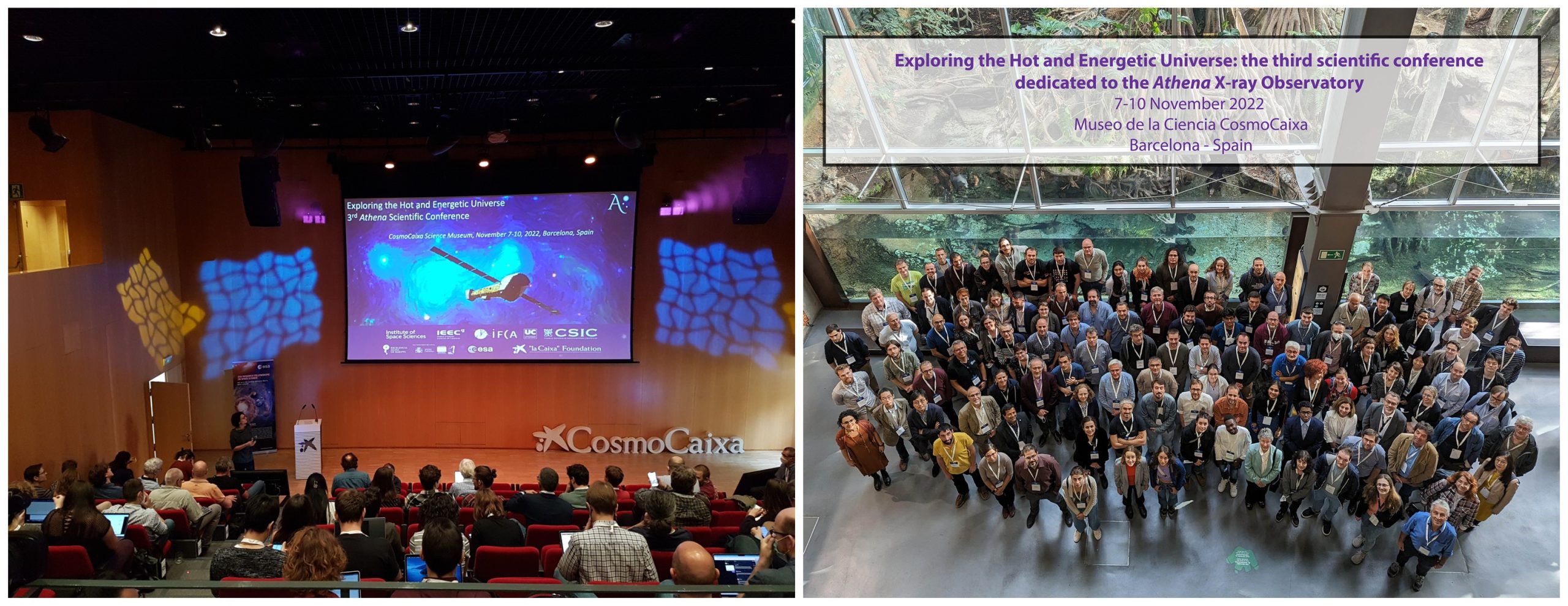
The main topics of the 3rd Athena conference included Athena mission status and technology development, galaxies and galaxy clusters, feedback in AGN and star-forming galaxies, formation and evolution of supermassive black holes, physics of black hole accretion, isolated and accreting neutron stars, pulsars, pulsar wind nebulae, SNR and ISM physics, star formation and evolution, planets, exo-planets and habitability, multi-messenger astrophysics, GRBs and the transient X-ray sky and physics beyond the standard model.
Our Contributions
The series of the annual RAGtime workshops has been organized at the Institute of Physics in Opava by the Relativistic Astrophysics Group (RAG) since 1999. The RAGtime 24 workshop was held in a hybrid mode on October 10-14, 2022 and had 86 registered participants (22 online), 58 talks (13 keynote talks) and one public lecture.
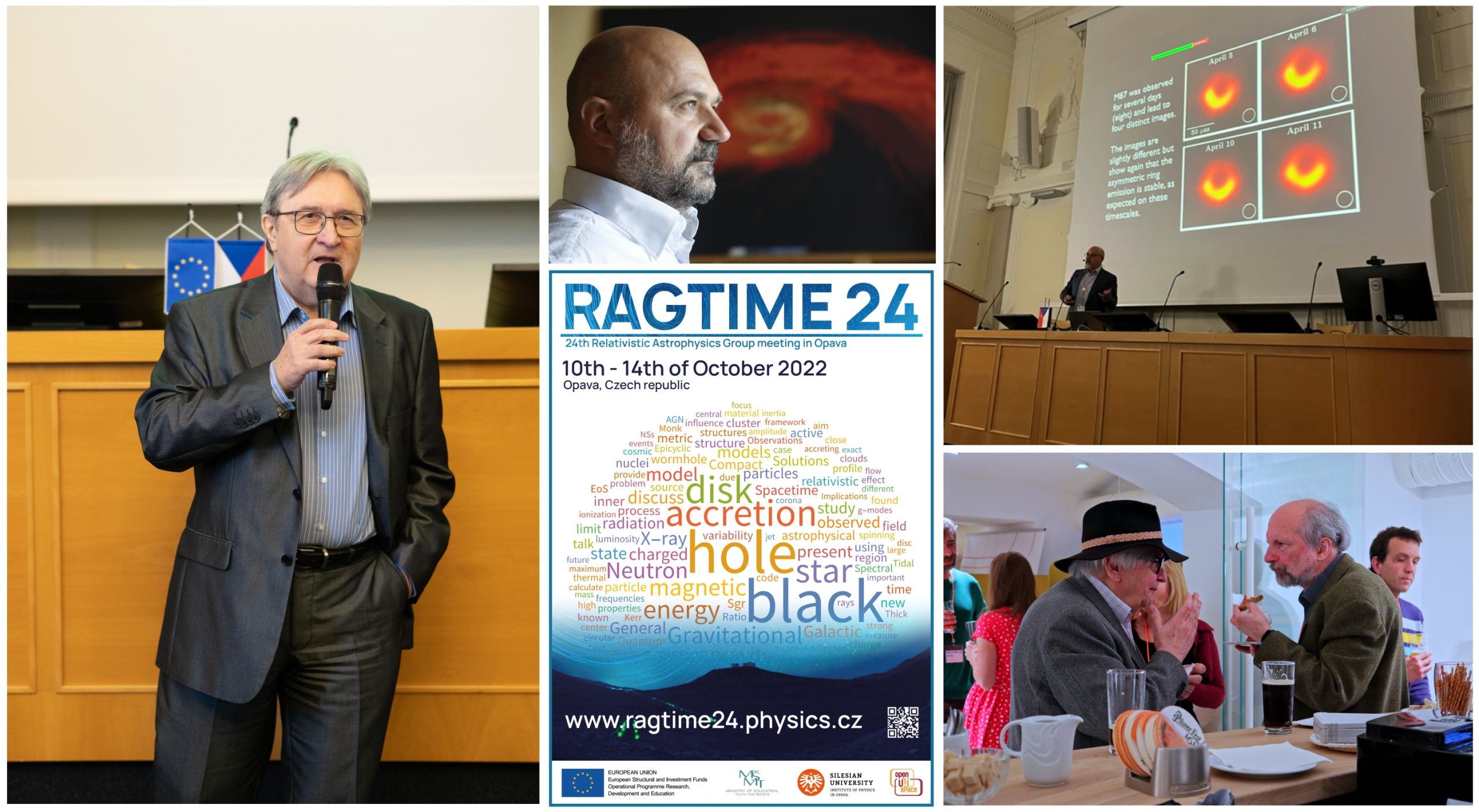
The scientific focus of the workshop was traditionally devoted mainly to problems of relativistic physics of black holes and neutron or quark stars. Large attention was given to confronting theoretical models with up-to-date observations available through both electromagnetic and gravitational wave window to the Universe. Special attention was devoted to the modelling of astrophysical effects in the combined strong gravity and relevant external magnetic fields. Current issues in accretion theory was explored. Participants furthermore attempted to address problems related to cosmology, mathematical aspects of the theory of relativity, and alternative theories of gravity. Special attention was put on national and international collaboration regarding the present and future cosmic X-ray missions.

The workshop was attended by multiple experts in the field and allowed for many valuable discussions and interactions between the participants. The workshop included a special public lecture “M87* and Sgr A*: Imaging supermassive black holes” given by Prof. Luciano Rezzolla on Monday, October 10, 2022, where he described how the first images of the supermassive black holes M87* and Sgr A* were obtained by the EHT collaboration.

The Proceedings of RAGtime workshop is published regularly by the organizers and it is listed in the SCOPUS database. Photo gallery from the RAGtime 24 workshop is available here.

Our Contributions
Since 1963, the Texas Symposium has been one of the major meetings on Relativistic Astrophysics where major astrophysical discoveries have been announced and discussed. Traditionally, it moves around the globe and takes place in different cities every 2 years. In September 2022, Gabriel Török, Martin Urbanec, Debora Lančová, Monika Matuszková and René Šprňa participated in the 31st Texas Symposium that was held in Prague, Czech Republic.
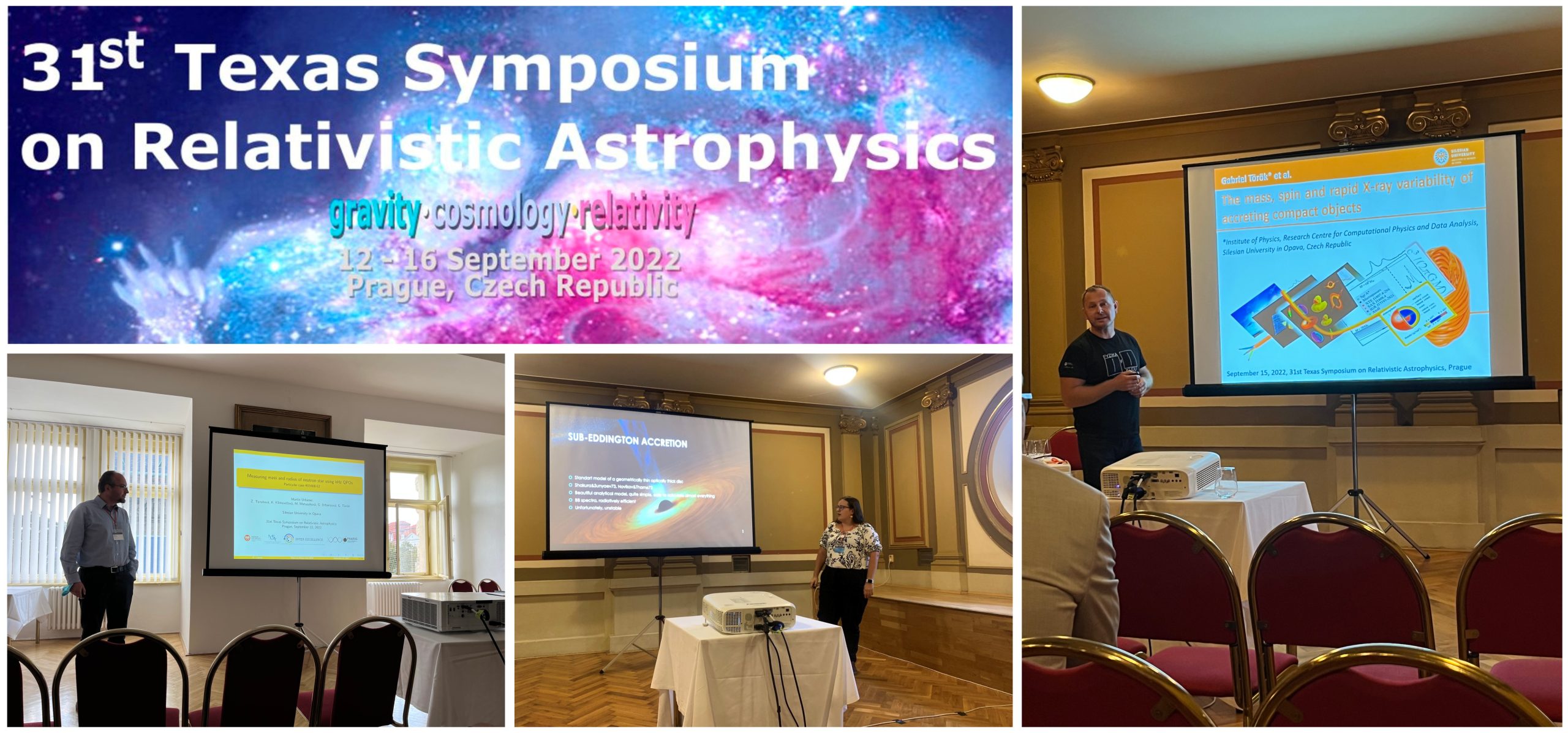
The conference was organized by the Prague Relativistic Astrophysics Group at the Astronomical Institute of The Czech Academy of Sciences and collaborators at the Institute of Physics of The Czech Academy of Sciences (FZU), the Faculty of Mathematics and Physics of Charles University, and our Institute of Physics of the Silesian University in Opava. It had more than 230 participants, 17 invited speakers, 160 contributed talks and more than 30 posters.
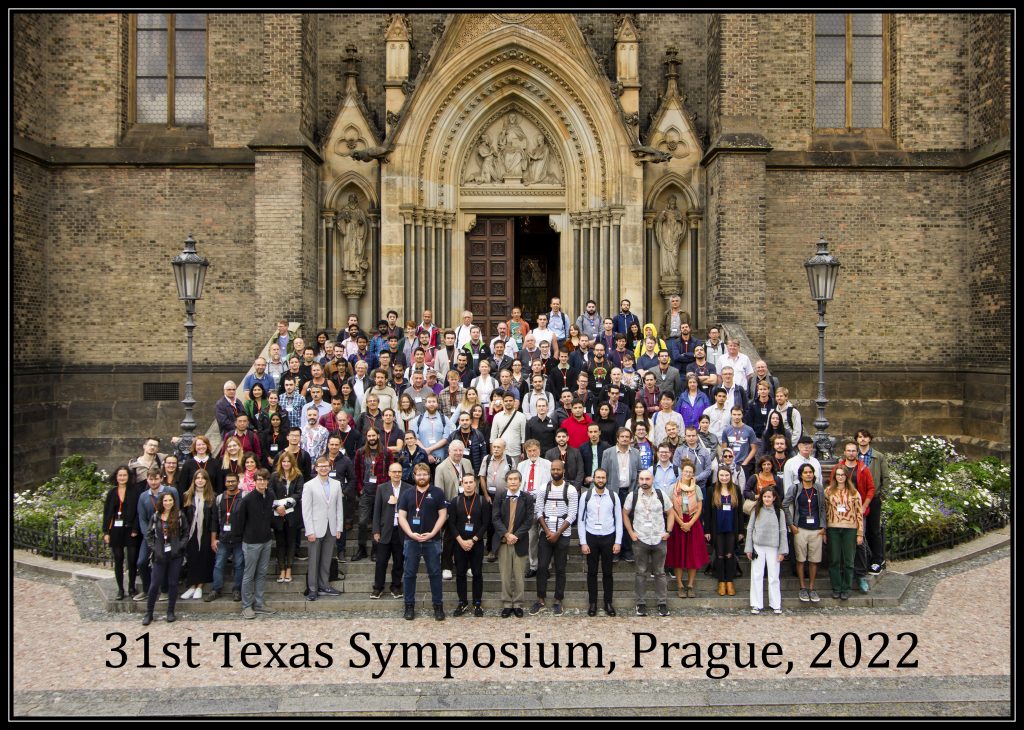
The main topics of the conference included gravity (classical, numerical, quantum, modified, tests), relativity (black holes, neutron stars, accretion, jets), multimessenger (cosmic rays, neutrinos, gamma rays, X-rays, gravitational waves), cosmology (cosmic microwave background, reionization, early universe, large scale structure, dark matter) and special sessions dedicated to Event Horizon Telescope, GRAVITY, X-ray polarimetry and James Webb Space Telescope.

Our Contributions
In September 2022, Eva Šrámková participated in the IWARA 2022 – the 10th International Workshop on Astronomy and Relativistic Astrophysics (From Quarks to Cosmos) that was held in a hybrid mode, taking place online and in Antigua, Guatemala. The workshop was the tenth in a series of meetings gathering scientists working on astroparticle physics, cosmology, general relativity and gravitation, nuclear physics, cosmic rays, exotic matter, new phenomena and new states of matter in the Universe, galaxies, quasars, black holes, neutron stars, pulsars, magnetars, gravitational waves, heavy ion collisions and related fields.
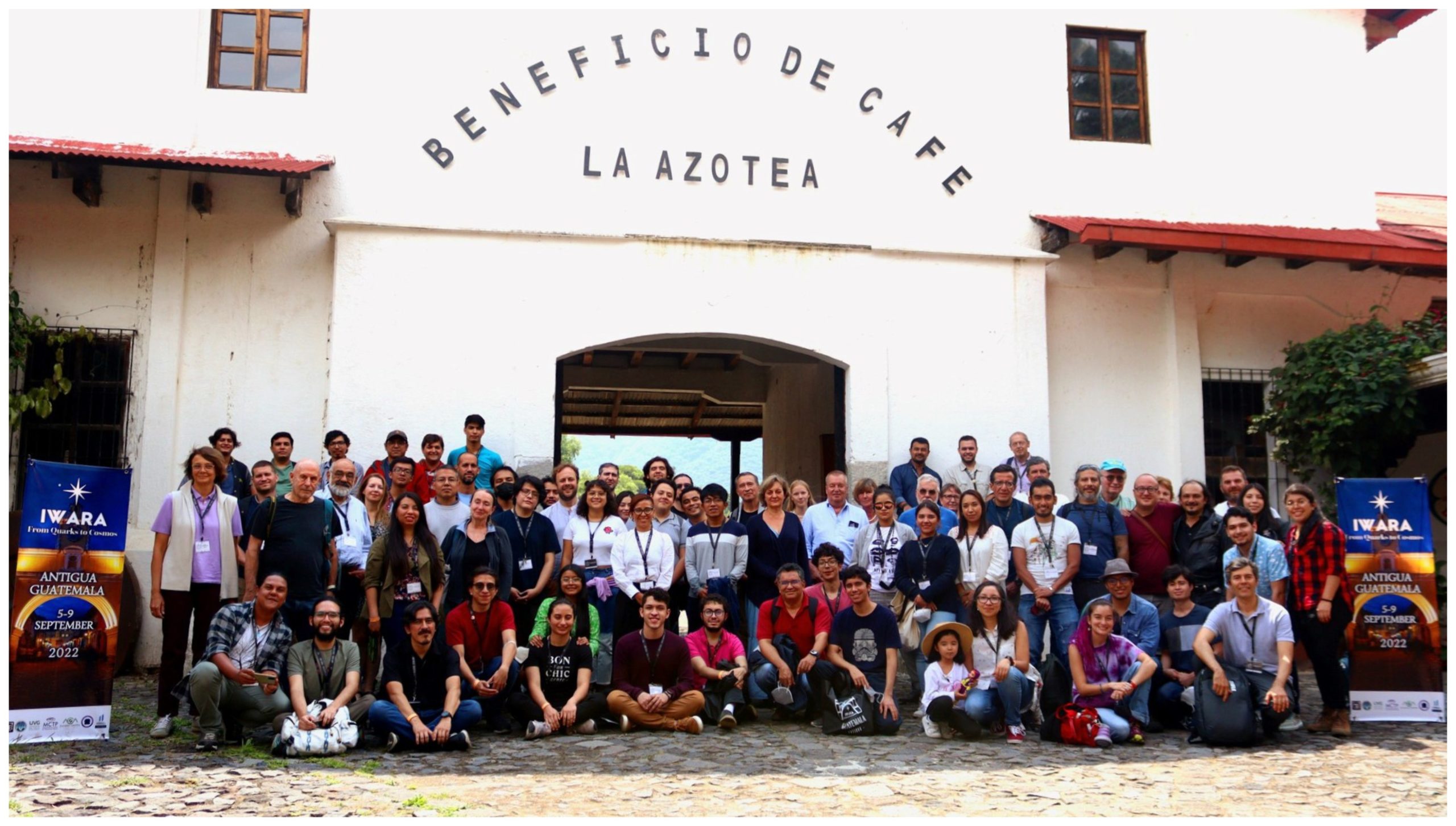
As in previous years, the IWARA 2022 meeting sessions consisted of invited and contributed talks and poster sessions. The proceedings of the event is published regularly by the Astronomische Nachrichten.

Our Contributions
In July 2022, Andrea Kotrlová participated online at the 2022 Sagan Exoplanet Summer Hybrid Workshop hosted by the NASA Exoplanet Science Institute (NExScI) at the California Institute of Technology in Pasadena, USA.
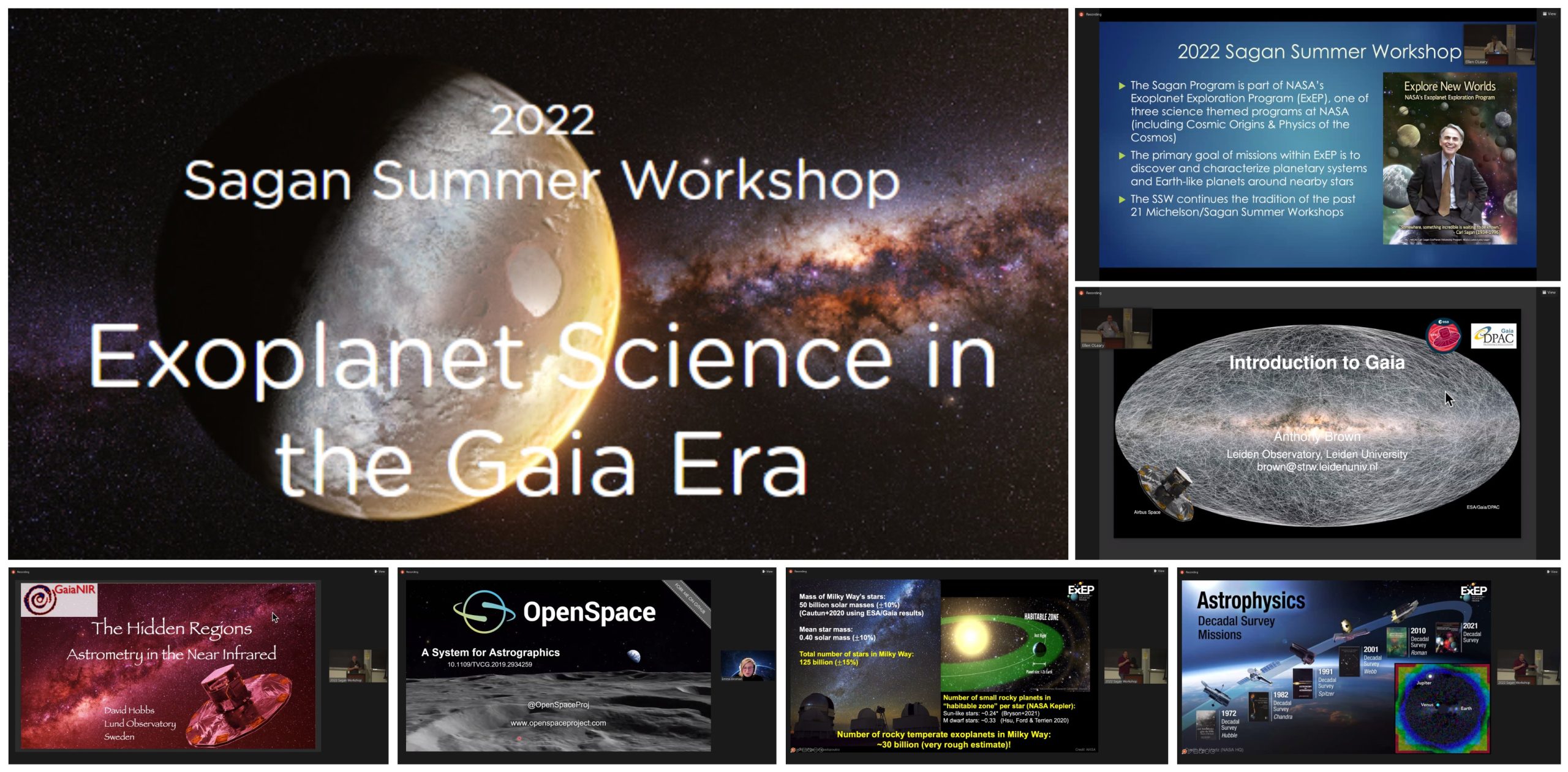
The Sagan Summer Workshops are held annually in late July. This year the workshop was held in a hybrid form from July 25-29, 2022 and was focused on the topic of exoplanet science in the Gaia era. The ESA Gaia mission has been mapping the Galaxy for over eight years, measuring very accurate positions and motions of over 1 billion stars. It has already greatly contributed to exoplanet science through the determination of more accurate stellar parameters, which in turn improve planet parameters, the detection of stellar companions, and the identification and characterization of young moving groups. In the near future, the unprecedented astrometric accuracy will result in the discovery of new exoplanets, as well as the characterization of known planets.

The workshop introduced the basics of astrometry, the impact of Gaia astrometry on astrophysics, and the astrometric detection and characterization of exoplanets. The synergy between the different planet detection techniques of astrometry, transits, radial velocities, and imaging have been discussed, as well as future advances in astrometry. The workshop included lecture presentations, hands-on sessions using either Jupyter notebooks or Google’s Colaboratory (Colab) tool, in-person and virtual poster sessions, and the opportunity to meet with the speakers. A record number of more than 1000 participants from more than 60 countries participated in this hybrid workshop. All workshop videos and materials are now posted online:
The Committee on Space Research (COSPAR) was established in 1958. Every second year, COSPAR calls for a Scientific Assembly. The objectives of COSPAR Assemblies are the promotion of scientific research in space on an international level, with emphasis on the free exchange of results, information, and opinions, and providing a forum, open to all scientists, for the discussion of problems that may affect space research.
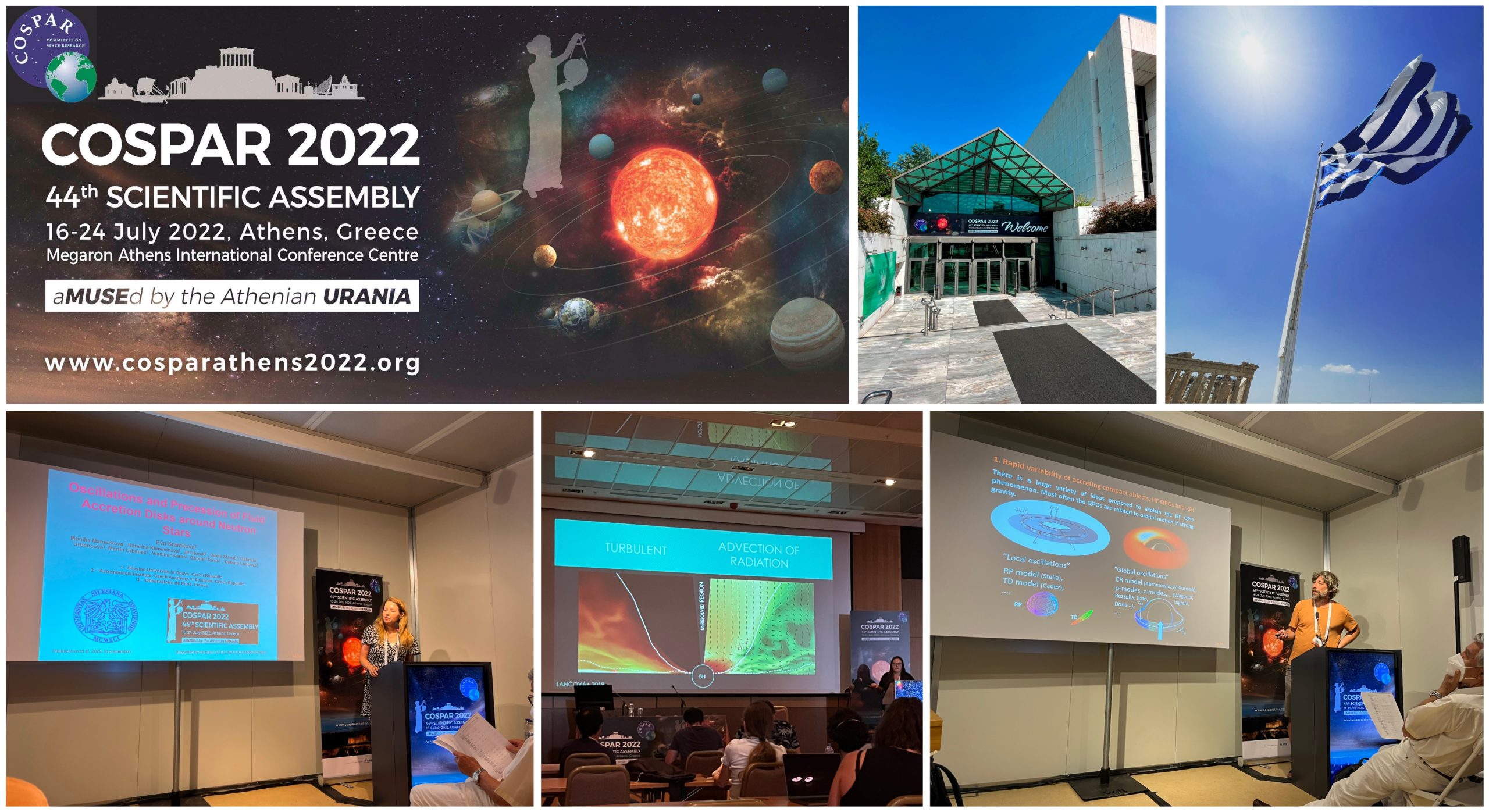
In July 2022, Eva Šrámková, Debora Lančová, Monika Matuszková and Jiří Horák participated in the 44th Scientific Assembly of the Committee on Space Research (COSPAR 2022) that was held as a hybrid event, taking place online and in Athens, Greece. It had more than 2 000 scientists from 65 countries, 1 000 speakers, 3 500 scientific announcements, 600 posters, 8 thematic sections, as well as around 140 sessions covering the fields of COSPAR Scientific Commissions.

Our Contributions
In June 2022, Debora Lančová participated in the NuSTAR Science Meeting 2022: Ten years of High-Energy Universe in Focus. This hybrid conference celebrating the tenth anniversary of NuSTAR‘s launch was held in Cagliari, Sardinia in Italy. NASA’s Nuclear Spectroscopic Telescope Array (NuSTAR) is the first focusing hard X-ray (> 10 keV) satellite in orbit, and is providing unprecedented data on energetic phenomena ranging from the Solar System to distant quasars. After a decade of operation, NuSTAR continues to open new horizons, discover fascinating objects, and expand our knowledge of the Universe.

The conference was a great opportunity to explore the range of science that NuSTAR is conducting, with sessions focused on topics including Galactic X-ray binaries, accreting compact objects, extreme transients, ultraluminous X-ray sources (ULXs), the census of obscured AGN in the local universe, black hole physics, and future high-energy facilities.
Our Contributions
In the summer of 2020, the ISSI (International Space Science Institute) directorate – partly motivated by the pandemic – started to prepare a series of online seminar talks scheduled for each Thursday at 5 pm CET and streamed online via Zoom. The series have become known as the Game Changers Seminars with almost 400 participants from all over the world and covered a wide range of subjects from astrophysics, solar physics and fundamental physics to planetary science, Earth observation missions, climate change and astrobiology. The talks were given by internationally renowned experts including two recent Nobel prize winners.

During the academic year 2021-2022, Andrea Kotrlová attended the online series of talks on the themes of Ideas and Findings about the Solar System, the Universe and our Terrestrial Environment, Habitability from Cosmic to Microbial Scales and Viewing Earth from Space – the Changing Environment and Climate of our Planet.

All webinars are recorded and are part of ISSI’s digital online library and posted on the ISSI Youtube channel. Game Changers videos with abstracts and CV’s of the speaker are available here, where upcoming talks are also advertised. The new series of ISSI Game Changers Seminars will focus on cosmology and starts in September 2022.
In June 2022, Debora Lančová participated in the XMM-Newton 2022 Science Workshop: Black Hole Accretion under the X-ray Microscope organized by the XMM-Newton Science Operations Centre of the European Space Agency. The conference was held in person at the European Space Astronomy Centre (ESAC/ESA) in Madrid, Spain.

The meeting focused on black hole accretion and its consequences, following the accretion flow from the direct relativistic environment of the black holes out to galactic scales. The two flagship X-ray missions XMM-Newton and Chandra are constantly expanding the frontiers of our knowledge and many further international X-ray observatories are continuously discovering new phenomena. Multi-wavelength observations, complementing the X-ray data, are often crucial to sharpen our view of the accretion phenomenon and its effects on its surroundings. The meeting aimed at providing an opportunity to discuss new results, open questions, and pathways for future progress in the field.
Our Contributions
During the academic year 2021-2022, Andrea Kotrlová attended the EAI Academy, an international educational program organized by the European Astrobiology Institute (EAI). The EAI Academy consisted of a series of 16 online seminars on topics related to astrobiology (e.g., coevolution of planetary geospheres, atmospheres and biospheres, prebiotic chemistry, habitability of exoplanets etc.).

The seminars were offered for free and were streamed online via Zoom every two weeks from October 2021 to June 2022. Each session included a 30-40 minute didactic talk given by a world-renowned expert. The talk was followed by about 20 minutes of questions and answers. The program has been very popular, it has about 350 subscribers and the seminars have had up to 200 online attendees from 32 countries. It provided a framework to meet online with the European astrobiology community and to acquire inter-disciplinary knowledge.
The program has been broadcasted by Centro de Astrobiología (CAB), a joint research institute of the Spanish National Research Council (CSIC) and the National Institute of Aerospace Technology (INTA). At the end of the academic year, CAB issued a certificate of participation to those who attended at least 10 seminars.

All past seminars have been recorded and are available on the CAB Youtube channel. List of all speakers and abstracts with links to recorded lectures can be found here. The program will be relaunched in September 2022 for the 2022-2023 academic year.
In May 2022, Martin Urbanec, Debora Lančová, Lenka Vozárová and René Šprňa participated in the PHAROS Conference 2022: The multi-messenger physics and astrophysics of neutron stars. The meeting was held fully in person at La Sapienza University of Rome, Italy.
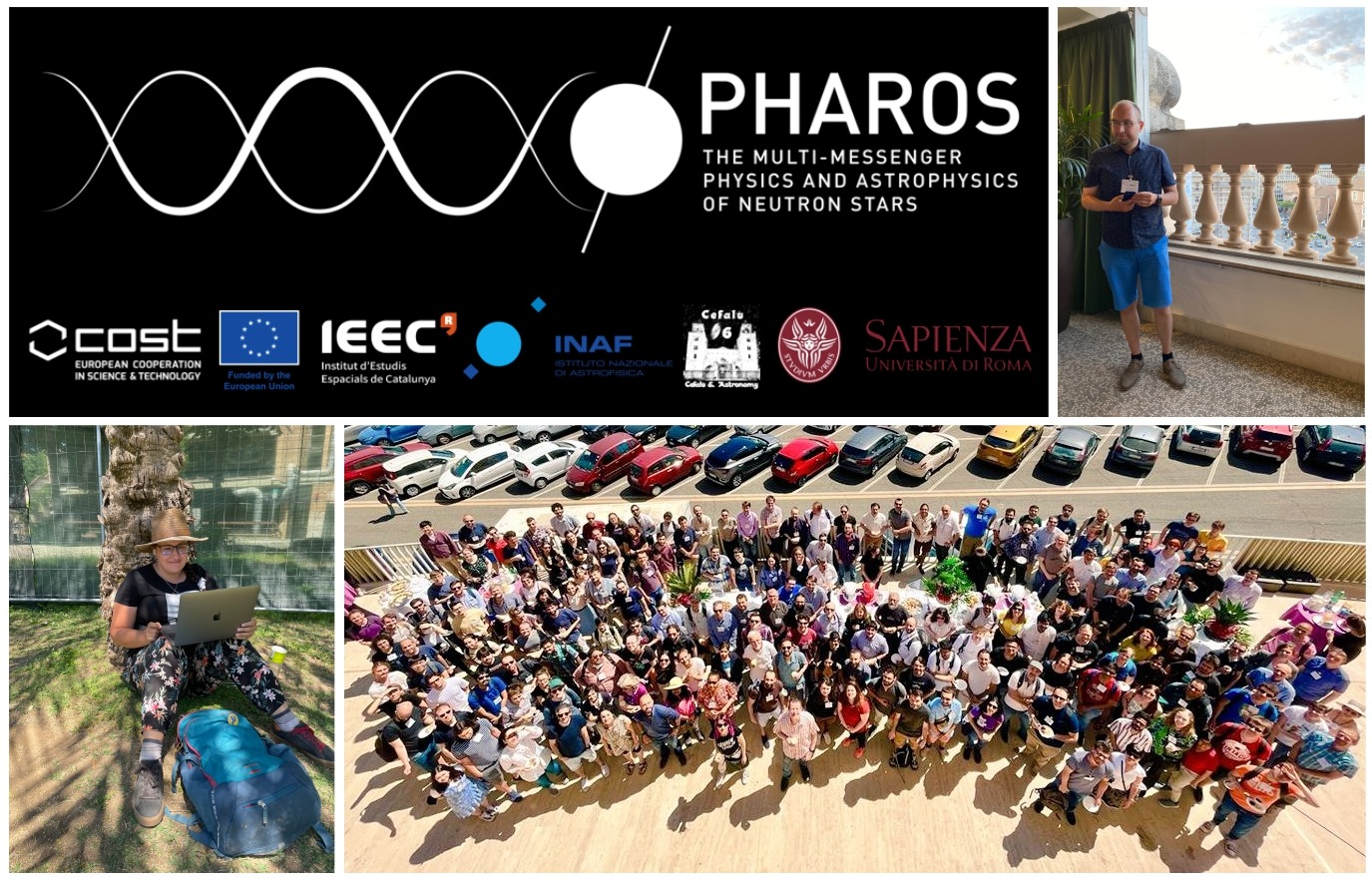
The PHAROS Conference 2022 was intended to gather experts and students working on neutron stars from any perspective: astronomical observations from radio to gamma-rays, modelling of their multi-band emission, gravitational waves of isolated and binary neutron stars, neutron star formation and evolution, equation of state and nuclear interiors, core collapse supernovae, connection with gamma-ray bursts, fast radio bursts and the transient universe in general.
Our Contributions

After the conference, Debora Lančová, Monika Matuszková, Lenka Vozárová and René Šprňa attended the workshop at the National Institute for Astrophysics (INAF) in Rome, where they discussed recent scientific findings with Prof. Luigi Stella from INAF-OAR (Astronomical Observatory of Rome) who has been cooperating with our institute for a long time.
In January 2022, Debora Lančová, Lenka Vozárová and René Šprňa participated in the 51st Saas-Fee Advanced Course organized by the Swiss Society for Astrophysics and Astronomy (SSAA) in Saas-Fee, a pedestrian village in the Swiss Alps surrounded by eighteen four-thousand-metre peaks.
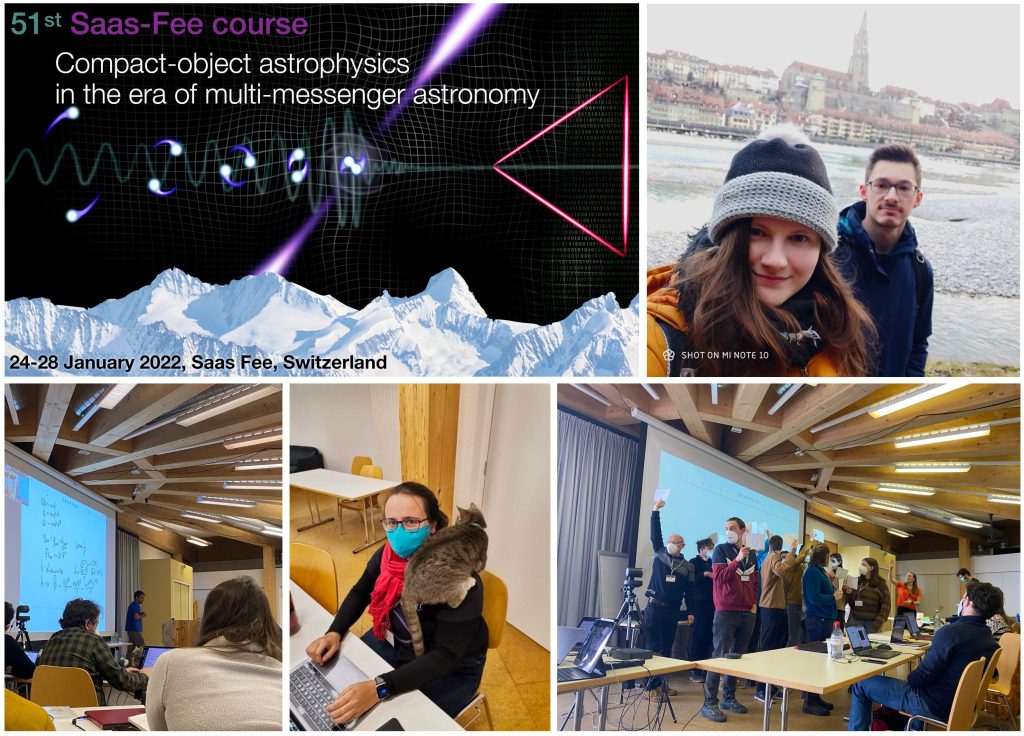
The Saas-Fee Advanced Course has taken place annually since 1971 and in 2022 it was devoted to Compact-Object Astrophysics in the Era of Multi-Messenger Astronomy. The course was primarily targeted at Ph.D. and advanced M.Sc. students and included a series of lectures given by distinguished lecturers that covered topics related to detection and analysis of gravitational wave data, astrophysical origin of coalescing double compact objects, analysis and interpretation of multi-messenger campaigns of coalescing double compact objects and understanding their electromagnetic signatures.

Formal lectures in the morning were followed by interactive hands-on sessions in the evenings, where the participants had the opportunity to get their hands on observational and simulation data and explore theoretical concepts with order-of-magnitude calculations. A several-hour-long afternoon break was scheduled, when the participants were encouraged to do winter sports or simply interact with each other.

Before the start of the course, our colleagues also spent a few days at the International Space Science Institute (ISSI) in Bern, whose one of the directors Prof. Dr. Maurizio Falanga has been cooperating with our institute for a long time.